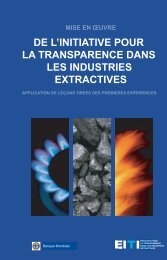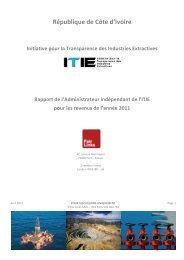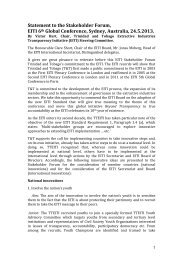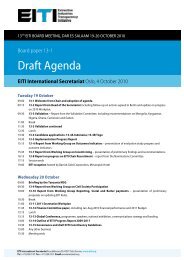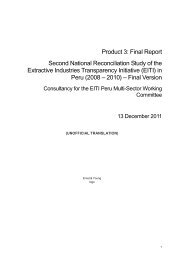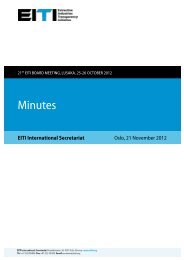Vietnam feasibility study - EITI
Vietnam feasibility study - EITI
Vietnam feasibility study - EITI
You also want an ePaper? Increase the reach of your titles
YUMPU automatically turns print PDFs into web optimized ePapers that Google loves.
26<br />
II.1.2 Tax responsibilities<br />
Tax is the main revenue of the state in mining activities. The following are some main taxes that the<br />
mining company is obliged to pay to the state.<br />
1. land, surface water taxes<br />
Land is regulated as the common property of the people to for which the state is the representative<br />
of the owner. Therefore, in mining activities, the company is liable for paying the taxes on the use of<br />
land and surface water. Land and surface water tax in any particular location is provided for by the<br />
Provincial People’s Committee based on the provisions of the Law on Land and land tax schedule<br />
issued by MOF.<br />
2. natural resources tax<br />
The natural resources tax is the biggest tax revenue that the state receives from mining activities.<br />
According to the Law on Natural Resource Taxes issued in 2009, the mining company is subjected to<br />
tax rates ranging from 1- 40%. Table 5 below lists tax rates applicable to some minerals.<br />
The Extractive Industries Transparency Initiative and the Implementation Perspective of <strong>Vietnam</strong><br />
table 6. schedule of tax rates applicable to some minerals<br />
No Group, type of natural resources Tax rate (%)<br />
I Metallic minerals<br />
1 Iron, manganese 7-20<br />
2 Titanium 7-20<br />
3 Gold 9-25<br />
4 Rare earth 12-25<br />
II Non-metallic minerals<br />
1 Land exploited for grading, work construction 3-10<br />
2 Stone, excluding stone for calcinations and production of cement; pebble; sand, excluding sand<br />
for producing glass<br />
5-15<br />
3 Granite, fire resistant clay 7-20<br />
4 Anthracite coal covered in mines 4-20<br />
5 Open anthracite coal 6-20<br />
6 Lignite, fat coal 6-20<br />
7 Other coals 4-20<br />
III Crude oil 6-40<br />
As the range of tax rates is rather wide, the MOF and Provincial People’s Committee shall provide<br />
specific tax rates as well as tax prices of particular minerals applicable to specific mines based on the<br />
exploitation conditions and investment policies of each location.<br />
3. export and import tax<br />
In exporting minerals, the extraction company is responsible for paying export taxes in accordance<br />
with provisions of the Law on Exports and Imports issued in 2005. The Standing Committee of the<br />
National Assembly issues resolutions on the group of taxable items and range of tax rates applicable<br />
to each group. According to Resolution No. 295/2007/NQ-UBTVQH12, the range of tax rates applicable<br />
to items of natural resources is from 0-40%. Depending on specific circumstances, MOF shall issue<br />
guiding documents to tax rates applicable to products in line with domestic legal documents and<br />
international commitments, especially to WTO, ASEAN, ASEAN - Japan, ASEAN - South Korea, ASEAN -<br />
China and other bilateral and multilateral commitments. The specific tax rate shall be implemented in<br />
accordance with provisions of Circular No. 216/2009/TT-BTC of MOF, dated 12 November 2009.



